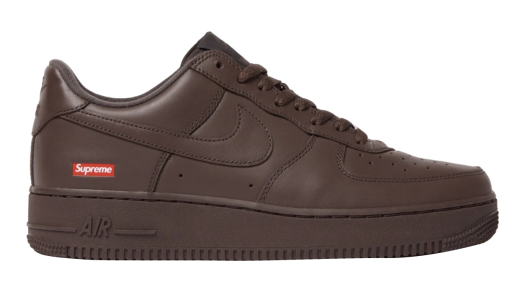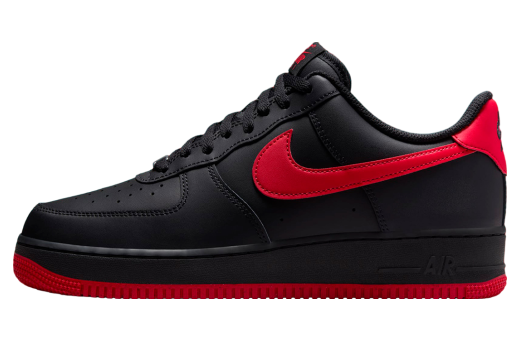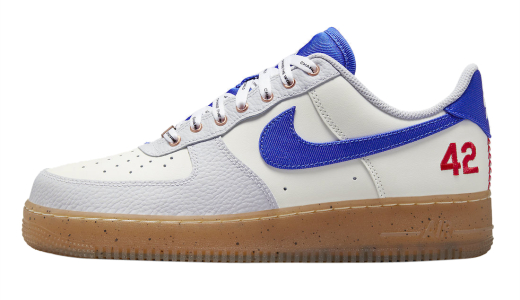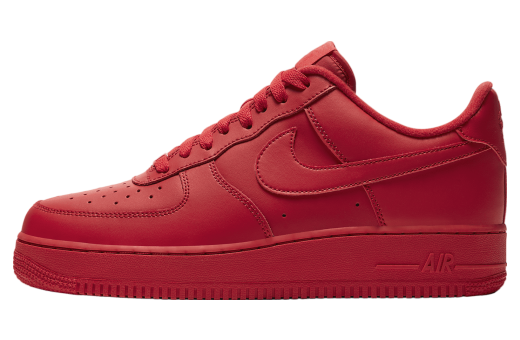Nike Air Force 1
The Nike Air Force 1, originally introduced in 1982, has solidified its status as one of the most iconic sneakers in footwear history. Designed by Bruce Kilgore, the Air Force 1 was the first basketball shoe to feature Nike's proprietary Air technology, which provides exceptional cushioning and support. Over the decades, the AF1 has transcended its basketball roots to become a cultural phenomenon, embraced by musicians, artists, and fashion enthusiasts alike. Its classic silhouette and versatile design have made it a staple in sneaker collections worldwide, while its myriad colorways and collaborations keep it continually relevant and exciting.
From its high-top beginnings to the popular low-top variations, the Nike Air Force 1 maintains a timeless appeal that bridges generations and subcultures. The durability and comfort of the shoe make it a practical choice, while its clean lines and expansive customization options offer a canvas for personal expression. The longevity of the Air Force 1's popularity can also be attributed to Nike's ability to innovate while staying true to the classic design elements that make the sneaker recognizable. Whether worn on the streets or styled in high-fashion looks, the Air Force 1 continues to be a symbol of style, versatility, and cultural significance.
History of Nike Air Force 1
The History of Nike Air Force 1: A Timeless Icon
Introduction
The Nike Air Force 1 (AF1), a timeless icon in the athletic and lifestyle footwear industries, has had a significant impact on popular culture since its release. With a rich history spanning several decades, the AF1 has transitioned from a cutting-edge basketball shoe to a cultural staple embraced by musicians, artists, and fashion enthusiasts worldwide. This comprehensive history covers the inception, evolution, and enduring legacy of the Nike Air Force 1.
Origins and Inception
The Nike Air Force 1 made its grand debut in 1982. Named after the aircraft that carries the President of the United States, the shoe was designed by Bruce Kilgore, who aimed to create a basketball shoe that would revolutionize on-court performance through innovative technology and design. The AF1 was groundbreaking in that it introduced Nike’s Air cushioning technology into basketball footwear for the first time.
Nike Air technology, developed in the late 1970s, featured pressurized air inside a tough yet flexible bag, providing superior cushioning and support. This technology, initially used in running shoes like the Nike Tailwind, was ingeniously adapted for basketball by Kilgore. The incorporation of the Air-Sole unit into the AF1’s midsole provided players with unmatched impact protection and responsiveness, changing the game of basketball footwear.
Technological and Design Innovations
One of the standout features of the Nike Air Force 1, besides the Air technology, was its high-top silhouette and ankle strap. These elements provided enhanced support and stability, crucial for the dynamic movements in basketball. The shoe’s sleek, minimalistic design—consisting of clean lines and premium leather—ensured durability and style, making it a versatile choice both on and off the court.
The AF1 was also notable for its pivot point on the outsole, designed specifically to facilitate the quick, multidirectional movements of basketball players. The combination of these innovations positioned the AF1 as a top-performing basketball shoe upon its release.
Cultural Impact and Popularity Surge
Despite its initial success as a basketball shoe, the Nike Air Force 1 was discontinued in 1984, only two years after its release. However, the shoe's popularity and demand continued to grow, particularly in urban communities and among sneaker enthusiasts. This grassroots movement led to Nike’s decision to re-release the AF1 in 1986, marking the beginning of the shoe’s transition from sportswear to a cultural icon.
The AF1 found a dedicated following in cities like New York and Baltimore, where local retailers began offering custom colorways and exclusive designs. The shoe’s association with hip-hop culture further fueled its popularity. In the late 1980s and early 1990s, hip-hop artists and influencers began sporting AF1s, and the shoe became a symbol of street style and self-expression.
The Role of Limited Releases and Collaborations
Nike capitalized on the growing demand by releasing numerous limited-edition versions and collaborations. These strategic moves not only kept the AF1 relevant but also cemented its status as a must-have sneaker. The brand’s collaborations with artists, designers, and other brands resulted in highly coveted iterations of the AF1, contributing to its enduring legacy.
One of the most iconic collaborations was with Roc-A-Fella Records in the early 2000s. The limited-edition AF1 featured the record label’s logo embroidered on the heel, symbolizing the shoe’s deep-rooted connection with hip-hop culture. Other notable collaborations include those with streetwear brands like Supreme and Off-White, which brought fresh perspectives and design elements to the classic silhouette.
Marketing Strategies and Commercial Success
Nike’s marketing strategies played a crucial role in the Air Force 1’s sustained success. The brand effectively leveraged celebrity endorsements, strategic product placements, and innovative advertising campaigns to maintain the shoe’s relevance. High-profile endorsements from athletes, musicians, and celebrities helped elevate the AF1’s status and appeal to a broader audience.
Moreover, Nike’s “1 Thology” campaign, launched in 2007 to celebrate the 25th anniversary of the AF1, showcased the shoe’s influence across various cultures and communities. The campaign highlighted stories from individuals who had embraced the AF1 and contributed to its cultural significance, reinforcing the idea that the shoe was more than just footwear—it was a symbol of identity and expression.
Evolution of the Air Force 1 Lineup
Over the years, the Nike Air Force 1 has seen numerous iterations and updates, reflecting changes in design trends, technology, and consumer preferences. The shoe has been released in different silhouettes, including the original high-top, as well as mid and low-top versions. These variations allowed the AF1 to appeal to diverse audiences and adapt to different fashion trends.
Nike also introduced updated versions of the AF1 with improved materials, construction techniques, and cushioning systems. The introduction of the Ultra and Flyknit versions, for instance, offered lightweight alternatives while retaining the iconic look of the traditional AF1. Additionally, the customization options provided by NikeID allowed consumers to design their own unique pairs, further personalizing the AF1 experience.
Enduring Legacy and Future Prospects
The Nike Air Force 1’s enduring legacy can be attributed to its ability to transcend generations, cultures, and subcultures. The shoe’s versatility and timeless design have made it a staple in both athletic and fashion contexts. Its impact reaches far beyond the basketball court, influencing streetwear, music, and art scenes globally.
As the AF1 approaches its 50th anniversary, it remains a cornerstone of Nike’s product lineup and a testament to the brand’s innovation and cultural relevance. The shoe’s ability to continuously evolve while retaining its core identity ensures that it will remain a significant player in the world of footwear for years to come.
Collaborations and special editions continue to push the boundaries of design and creativity, while advancements in materials and sustainability reflect the evolving demands of modern consumers. With an unwavering fan base and a rich history of reinvention, the Nike Air Force 1 is poised to continue its legacy as a symbol of inspiration, innovation, and cultural significance.
Conclusion
The Nike Air Force 1 has undoubtedly cemented its place in history as one of the most iconic and influential sneakers of all time. From its inception as a revolutionary basketball shoe to its ascent as a cultural phenomenon, the AF1 has consistently set trends and broken barriers. Its impact on sports, fashion, and popular culture is a testament to its timeless design and the visionary minds behind its creation. As we look to the future, the Nike Air Force 1 will continue to inspire and captivate new generations, embodying the spirit of innovation and self-expression that has defined its legacy.























